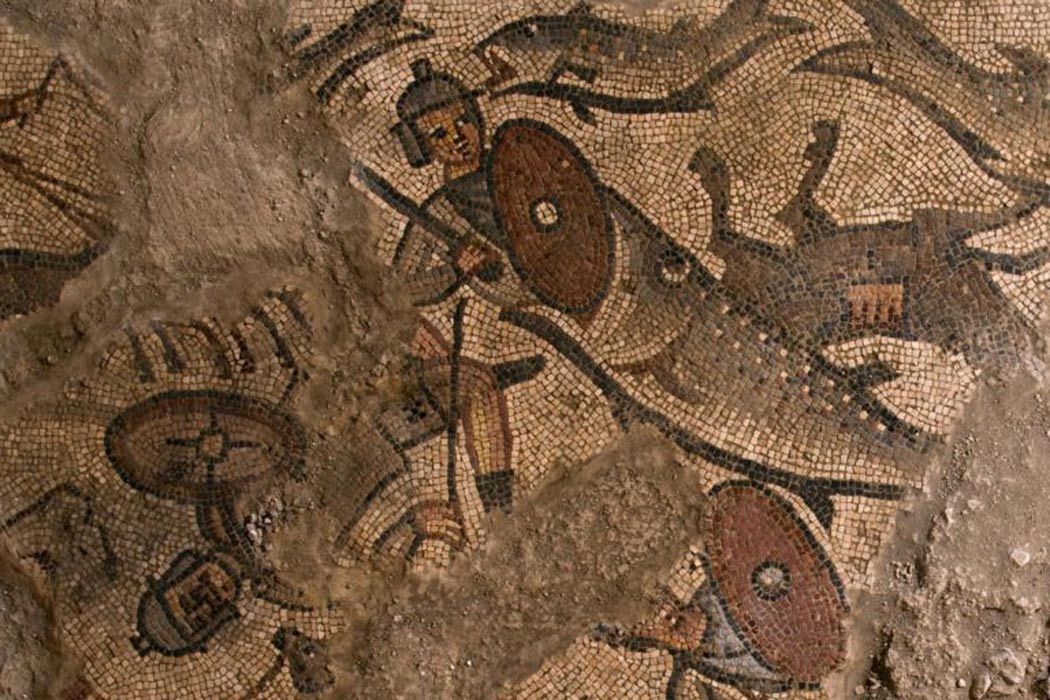Experts Uncover Rare Mosaics Showing Biblical Scenes in Ancient Synagogue in Galilee
Mosaics from the 5 th century AD, one depicting Noah’s ark and the other the parting of the Red Sea by Moses, have been excavated in an ancient Jewish village in Galilee, Israel. The synagogue in which the mosaics have been excavated show other scenes, including battle, possibly Alexander the Great visiting Palestine and a triumphal parade with elephants. Also found at the site of Huqoq, the ancient village, were coins spanning 2,300 years.
Depictions of the two Old Testament stories are rare in ancient mosaics, so the archaeologists and researchers working on the find are excited about this June’s find. Experts have removed the mosaics for preservation and backfilled the site of the synagogue.
“These scenes are very rare in ancient synagogues,” said Jodi Magness, a professor in the University of North Carolina at Chapel Hill College of Arts and Sciences in a news release. “The only other examples that have been found are at Gerasa/Jerash in Jordan and Mopsuestia/Misis in Turkey (Noah’s Ark), and at Khirbet Wadi Hamam in Israel and Dura Europos in Syria (the parting of the Red Sea).”
Dr. Magness and Shua Kisilevitz of the Israel Antiquities Authority are directing several other institutions in the dig.
One mosaic on the floor of the nave or center of the hall portrays an ark with pairs of animals, including lions, bears, leopards, elephants and snakes. The mosaic also shows donkeys, ostriches, camels, sheep and goats.

Genesis 6:19: “You are to bring into the ark two of all living creatures, male and female, to keep them alive with you.” This mosaic detail shows two donkeys to be led onto Noah’s ark. (Photo credit: Jim Haberman)
Another scene shows pharaoh’s troops being swallowed by large fish after Moses led the Israelites out of Egypt, as told in the book of Genesis (see photo at the top of the page). The soldiers are depicted surrounded by overturned chariots with chariot drivers and horses.
These are not the first mosaics discovered at the synagogue. In 2012, one depicting Samson and the foxes was found in the east aisle, a story from Judges 15:4. Then, in 2013, adjacent to it the researchers discovered a mosaic depicting Samson carrying the gate of Gaza, a story from Judges 16:3.
In the east aisle in 2013 and 2014, the team uncovered the only known non-biblical story adorning an ancient synagogue. It may depict the legendary meeting between the Jewish high priest and Alexander the Great. Alexander visited the Galilee, the northernmost region of Palestine, in the 4 th century BC.

Head of a Greek military ruler, possibly Alexander of Macedon, in a mosaic that shows the only non-biblical scene known in an ancient synagogue. Photo credit: Jim Haberman)
In 2015, a mosaic panel was discovered that shows a Hebrew inscription surrounded by animals, human figures and putti and other mythological creatures.
Dr. Magness says in the press release:
‘This is by far the most extensive series of biblical stories ever found decorating the mosaic floor of an ancient synagogue. The arrangement of the mosaics in panels on the floor brings to mind the synagogue at Dura Europos in Syria, where an array of biblical stories is painted in panels on the walls.’
Huqoq is an ancient Jewish village about 3 miles west of Capernaum and Magadala. A consortium of universities has done five seasons of excavations at the site so far. The synagogue dates to the Late Roman and Byzantine eras.
As for the coins, “The ancient coins at Huqoq, which I study, span 2,300 years at the site and are critical for our knowledge of the monumental synagogue and the associated village,” said Baylor University coin specialist and art history professor Nathan Elkins in a press release. The release does not elaborate on the coins.
The Huqoq Excavation Project has a website here.
Top image: A big fish swallows an ancient Egyptian soldier on one of the mosaics found on the floor of the synagogue. (Photo credit: Jim Haberman)
By Mark Miller




















Comments
Very good finds ! These mosaics could be photographed and made into posters to sell world wide :) That would be cool..